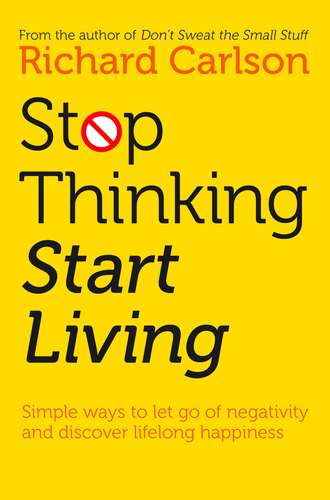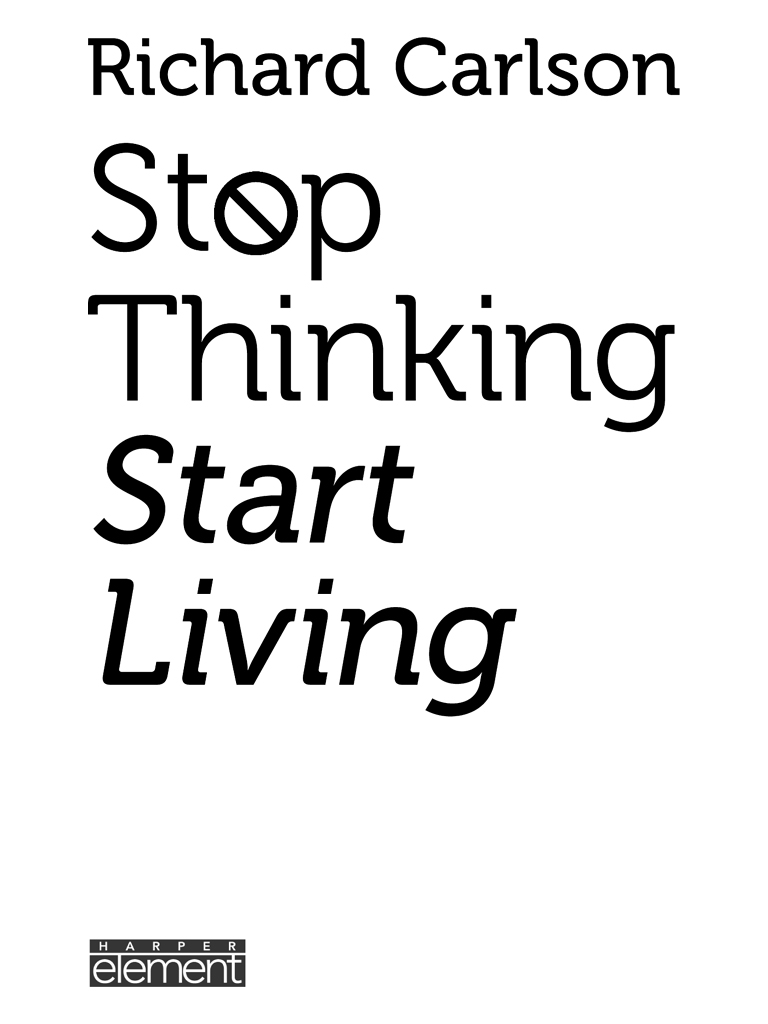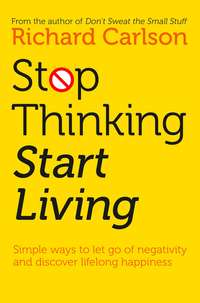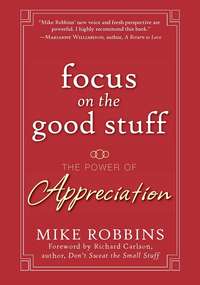
Полная версия
Stop Thinking, Start Living


Copyright
HarperElement
An imprint of HarperCollins Publishers 1 london Bridge Street London SE1 9GF
www.harpercollins.co.uk

and HarperElement are trademarks of
HarperCollins Publishers Limited
Originally published as You Can Feel Good Again by Thorsons 1993 First published by Thorsons 1997 Published by Element 2003 This edition published by HarperElement 2012
39
FIRST EDITION
© Richard Carlson 1993
Richard Carlson asserts the moral right to be identified as the author of this work
A catalogue record of this book is available from the British Library
All rights reserved under International and Pan-American Copyright Conventions. By payment of the required fees, you have been granted the non-exclusive, non-transferable right to access and read the text of this ebook on-screen. No part of this text may be reproduced, transmitted, down-loaded, decompiled, reverse engineered, or stored in or introduced into any information storage and retrieval system, in any form or by any means, whether electronic or mechanical, now known or hereinafter invented, without the express written permission of HarperCollins ebooks.
Paperback ISBN: 9780722535479
Ebook edition © August 2012 ISBN: 9780007383092
Version 2016-10-21
Contents
Title Page
Copyright
Introduction
1 Possibilities
2 Your Thoughts and the Way You Feel
3 Healthy Psychological Functioning
4 Dismissing Thoughts
5 Wisdom
6 Thoughts Grow with Attention
7 Thought Systems
8 Choice Points
9 The Thinking Habit
10 Moods
11 Living in the Present Moment
12 Life Is Like a Pendulum
13 Mental Health and the Dynamics of Unhappiness
14 Grief and Loss
15 Illness and Death
16 Many Problems, One Solution
17 Unhappiness Is Your Curriculum
18 The Art of Optimism
19 Happiness and Gratitude
Footnotes
List of Searchable Terms
About the Publisher
Introduction
I respectfully ask that you try to forget everything you have ever been told about unhappiness, pessimism and depression – where these feelings come from, how serious they are, and how difficult they are to overcome. Try to forget about all the attempts you have made that have failed and all the approaches that promised results but did not deliver. Even though I am going to explain how you can begin to feel better today, I don’t ask you to believe me with blind faith. Instead, I ask that you use your own common sense when evaluating what you are about to read. By the time you finish this book I believe you will not only feel better, but also understand exactly why most approaches failed you before.
The way to get the most out of this book is to approach it with an open mind. See whether it makes sense to you and if it sounds like something that you already know intuitively. Some of what I propose will be quite different from what you have been exposed to before. Don’t let this be an obstacle to getting the help you deserve. Keep in mind that if what you have already learned was the answer you were looking for, you wouldn’t be reading this book today. You would be out enjoying your life.
The information given here is different because it represents a new understanding in the field of mental health. It doesn’t build on other approaches you may already be familiar with. If you can digest and ‘take to heart’ the information in this book, you will feel better right away. There is very little effort involved; all you have to do is understand what you read on an intuitive level and make a gentle effort to put your understanding into practice. As you will see, I don’t offer any fancy techniques or any sophisticated psychological theories to sift through. What I offer you is a simple yet profound commonsense-based understanding of mental health and happiness that really works, and that can be implemented immediately. I have seen people who have been unhappy or depressed for as many as 30 years walk away from my office feeling better than they can ever remember. And what’s more, the good feeling you will learn to tap into sticks with you.
I am a stress-management consultant who teaches people some very simple facts about their own internal functioning – what makes them tick and what makes them fall apart. The principles that I teach are generic, meaning they apply to everyone. I receive referrals from therapists around the country who have seen their clients rid themselves of depression as a result of what I teach. As people learn about the habitual processes that contribute to their own misery, and the ways that they use their own minds to sabotage their lives, they quickly discover a natural and relatively effortless way to escape the grips of unhappiness and lifelong pessimism.
My approach is based on a set of principles known as the Psychology of Mind.1 It is being used by growing numbers of therapists, consultants and educators, with spectacular results! The methods you will learn have been extrapolated from these principles in a way that is geared towards freeing you from unhappiness.
Many professionals now teaching this approach have come to believe that a majority of the more ‘conventional’ therapeutic approaches available today to treat unhappiness can actually make matters worse instead of better. This is not to say that there aren’t excellent, well-qualified therapists practising traditional therapy – there most certainly are. What you may discover, however, is that many of the practices that therapists currently use tend to fuel an already depressed state. Clients are directed to ‘get in touch’ with their most negative feelings and analyse their pasts in order to transcend their present situations. They are asked to study, if not relive, their childhood as well as their more recent past so that they can better understand the psychological damage that was inflicted on them.
One of the consistent problems I have seen in working with clients who have ‘given up’ on traditional therapy is that each time a new trauma is uncovered, the client is in effect starting over again. There are always new sessions designed to get to the bottom of each additional ‘issue’ and to explore the negative feelings that go along with recounting them. Each specific issue entails more negative feelings to explore. Many therapists insist that unless people deal head-on with their negative experiences and unconscious drives, they will be miserable forever. You must keep in mind, when deciding whether traditional therapy makes sense to you, that the therapists who tell you this are almost always paid by the hour!
In defence of therapists, I don’t think I’ve ever met one who would intentionally keep a client longer than they felt was absolutely necessary. Nevertheless, there is a certain conflict of interest to be very cautious of: if you get better, the therapist loses you as a client! If you have been in therapy for an extended period of time and are still unhappy, you may want to reconsider your treatment. Is more of the same really going to help? Is going deeper into your pain and suffering really going to help you experience joy? Is getting in touch with more negativity really going to make you feel less negative? I doubt it. History shows us that this route often doesn’t work.
Does this mean that therapy is useless? No. I would say, however, that success in therapy depends far more on the mental health and happiness of the therapist than it does on reliving past traumas and pain. A skilled therapist who is also a happy, vibrant person will most certainly be able to pass along at least some of her happiness almost regardless of the specific approach she uses.
One of the most striking observations that many people make when attending a Psychology of Mind seminar or when they have a private session with a consultant, is that the people who teach Psychology of Mind are very happy people themselves. I have come to believe that unless a person is happy himself, it’s very difficult, if not impossible, to teach someone else to be happy. How can an unhappy person, who is caught up in personal problems, teach an already unhappy person to feel joy? I feel grateful to be able to say that I am, indeed, a happy person, and I hope the feeling I bring to life will touch you as you read this book.
Who Is this Book for?
Carl Jung once said, ‘The greatest affliction affecting mankind isn’t serious mental illness – but the general uneasiness and unhappiness that is so prevalent in our society.’ Jung believed, as I do, that many people experience life in a ‘lifeless’ manner. Many if not most people have lost touch with the mystery and magic that surrounds us. The first step towards living fully is simply feeling better.
This book was written for anyone who would like to feel better than they presently do – anyone who frequently experiences ‘the blues’, ongoing sadness, a pessimistic outlook, frequent unhappiness, internal misery, a lack of gratitude about the gift of life – or someone who simply wishes to feel better. It is an outgrowth of an earlier book, You Can Be Happy No Matter What (New World Library, 1992). I received hundreds of letters and phone calls from readers who appreciated the principles of happiness that I spoke about, yet wanted to hear more specifically about how to get themselves out of the ‘lower states of mind’ that pessimistic people find themselves in.
The approach to happiness outlined in this book can help virtually anyone improve their mental outlook and the quality of their life. It should not, however, be used in lieu of professional treatment if you suffer from serious depression, suicidal urges or other serious mental illness. If you experience serious depression, please seek professional guidance before reading this book and attempting to implement the philosophy. Your doctor or counsellor may want you to use the ideas presented here in conjunction with your therapy. I certainly hope so, but please check first.
This book was written to address Jung’s assessment of the state of humankind, the general level of unhappiness that surrounds us. I will show you how to rid yourself of the negative feelings that can take over your life and replace them with the feelings of gratitude, happiness and love.
I will also show you how to access a place within yourself where ‘feeling good’ already exists, as well as how to detect those mental processes that take you away from this place. I have never met a person who didn’t feel better after learning this simple approach. Once you learn how you create unhappiness in your life with your own thinking – and once you learn how to stop this pattern – you will certainly be far more hesitant to continue or return to any destructive psychological tendencies you may have.
Approach the ideas here with an open mind and a curious heart. Don’t discount anything as being too simplistic until you have had an honest chance to practise what you learn and assess how you feel. If you read with your own common sense as your guide – remembering that your goal is to be happier – I believe you will be pleasantly surprised at how good you can feel. It really is true: you can feel good again.
One / Possibilities
Jim and Yvonne had been married for 32 mostly unhappy years when they discovered that Jim had a cancerous life-threatening tumour. Prior to discovering this information, the couple had lived together in an almost constant state of irritation. There was frequent conflict and anger, ongoing disputes and disagreement on virtually every issue surrounding their lives together. Their love for each other had been, in Jim’s words, ‘lost many years ago’.
A curious thing happened the moment they found out about the tumour. Both Jim and Yvonne experienced a sudden shift in their consciousness. The anger that had suffocated their love for so many years disappeared, their disagreements faded away and now seemed insignificant, and their love for one another resurfaced, almost magically, as though it had never left to begin with.
What happened? This couple experienced what is commonly referred to as ‘a change of heart’. No one knows exactly how or when this kind of sudden shift or change will occur, but we do know that they exist and that they are possible.
A sudden shift in consciousness can occur in any area of human life that has to do with how we feel, whether it be relationships, feeling anxious, feeling down, or any other immobilizing emotion. Consider an eight-year-old child who goes to bed every night frightened by the thought of an imagined monster behind the wardrobe door. Suddenly, one day, out of nowhere, she realizes that the monster isn’t real, that it exists only in her own mind. Interesting questions include: Why did the child have this realization on this particular day? What was it that made her realize the monster wasn’t real? The answers to these questions are surprisingly vague. We don’t know for sure, except to say that a new level of understanding surfaced within the consciousness of the child.
Another example of a sudden shift is the person who swears that he is going to stop smoking. Week after week, year after year, he promises he’s going to do it. You, as a friend, have heard the same story many times. Then, one day, for no apparent reason, your friend tells you the very same thing, only this time you know that he means it. Something is different. Something has changed. You can’t quite put your finger on it, but you know he will never smoke again. And indeed, he never does.
While the particulars of each sudden shift are unique, there are common denominators that seem to exist in all cases. First, the ‘shift’ itself doesn’t necessarily build on what we already know, but instead is seen suddenly, as if out of nowhere. In other words, the amount of information we have on the subject isn’t the critical factor. For example, I was working with a client, George, who had spent his entire life feeling prejudice about people of a specific race. He had a sudden shift in his perspective and realized (in his words), ‘What a fool I have been.’ What made this particular example so intriguing to me was that the two of us had never spoken about his prejudice. I never even knew he had this problem. His realization came about as he was discussing how his own thinking sometimes got in the way of his relationship with his wife. The shift that occurred in his consciousness was achieved without obtaining additional information about ‘the problem’. He had intellectually known for years that all prejudice stems from ignorance, yet he still felt prejudice, until that moment. Something shifted within him while he was thinking about something else.
I had a sudden shift of my own that is equally difficult to explain. I had spent my entire life frightened to death of public speaking. The very thought of speaking to a group made me sweat, and in two instances I actually fainted! Then, one day while eating lunch with some friends at a conference I was attending, I realized there was nothing to fear. I can’t explain exactly why or how I had this insight, only that it happened. To this day, I am very comfortable speaking to groups of any size and do so quite frequently.
Second, sudden shifts are accompanied by a feeling of inspiration, sometimes described as ‘a light feeling’, or ‘a nice feeling’. Yvonne and Jim each described their sudden shift as a ‘feeling of incredible relief’, as though a huge emotional burden had been lifted. Many clients have reported to me similar feelings of being ‘uplifted’ in some powerful way as they experienced an insight that changed the way they looked at life. This feeling is often described as a sense of self-confidence. Later, I will discuss this in a context of your healthy psychological functioning.
Finally, sudden shifts are permanent in nature. When a shift occurs, there doesn’t seem to be any turning back, at least not all the way. For example, it’s hard for me to imagine being frightened by the act of speaking to a group. I can, however, have empathy for those who do, because I remember what it feels like. The idea of Yvonne and Jim hating each other, as they did for so long, seems ridiculous. And my client George chuckles at the thought of disliking someone because of the colour of his skin. This is the nature of insight – it happens, and from that moment forward life looks different.
An interesting and important point about sudden shifts is this: there is no relationship between the ‘feeling better’ aspect of sudden shifts and the external appearance of life getting better. So, for example, a person who experiences a sudden shift in the way she feels about her finances didn’t do so because she had just inherited a large estate or won the football pools. She experienced the shift because she looked at the same set of facts in a new way. Whatever it was that she saw, it affected her enough that money will no longer be a source of inner conflict in her life.
Certainly Yvonne and Jim were no better off. To the contrary, Jim was given a terminal diagnosis. Yet both he and Yvonne felt more love for each other than ever before.
Likewise, the child who had the realization about the imagined monster in her wardrobe wasn’t any better off. The monster was never there to begin with! This is the nature of sudden shifts. They occur through a shift in understanding – not through a change in circumstance.
This is a book about possibilities. Be open to the possibility that this book will help you have your own sudden shift. If you do, your experience of life will change before your eyes. You will feel better, more joyful, more relaxed, and more secure. Absolutely nothing needs to change in your life in order for you to feel better. You simply need to see something about the nature of your own thinking that you didn’t see before. Your sudden shift can happen instantly and it can be profound.
Commitment
As you will see throughout this book, happiness is a moment-to-moment choice that each of us makes. In order to be happy, you must first decide to be happy. You must make a commitment to happiness.
It’s important to know that commitment to learning the art of happiness is not exactly what it seems to be at first glance. Most people make the mistake of confusing commitment to happiness with the decision to make their life better in some way. Although these two ideas seem related, they are not necessarily so. As you have probably noticed, you can change everything in your life without affecting your level of happiness one single bit. You can earn more money, get yourself out of trouble, meet new friends, get a new job, solve a problem, get a degree, get married, or acquire something you have always wanted, yet still feel unsatisfied. The reason for this is that happiness exists independently of your circumstances; it’s a feeling that you can learn to live in.
The way to get the most out of this book is to approach it with the understanding that it’s possible to learn to be happy without changing anything in your life – except your relationship to your own thinking. The American philosopher Emerson once said, ‘The ancestor to every action is a thought.’ Everything in your life is a function of the way you relate to your thinking. As you think, so shall you be.
Commitment is a powerful tool for change. It takes pressure off you by removing the uncertainty that often accompanies a lack of commitment. Marriage, for example, is a commitment. When a couple gets married there is a reasonable belief that, regardless of what might happen, the commitment will carry the couple through. Prior to marriage, people often feel insecure about losing their partner. The commitment relieves their anxiety and gives them the freedom to ‘let go’ of their concerns; it fosters hope.
Without commitment, success in any venture is difficult. Whether you are dieting, studying for an exam, learning to play tennis, starting a project or deciding to be happy, commitment is an important step.
When you make a commitment to happiness you are in effect saying: ‘There is so much in life that I can’t control – the world, other people and their choices and reactions, accidents, imperfections, suffering, hardships. Yet this is my life and regardless of what happens, I’m going to be happy.’
Whenever you attach conditions to your happiness you won’t experience it. The same mental process that attaches your happiness to a specific outcome will only repeat that pattern once that outcome is obtained. A person who believes that ‘having children’ will make her happy will then create new conditions to be met once the children arrive. She may then believe that she will be happy when the infant stage is over, or the terrible two’s, or when she has enough money to meet her growing family’s needs. Your commitment to happiness itself allows you to let go of all your preconditions. Instead of having conditions, you say to yourself: ‘No matter how difficult it seems, I’m going to practise the mental processes that will lead me to happiness.’
Being happy isn’t always easy. In fact, it can be one of the great challenges in life. True maturity means taking responsibility for our own happiness – right now. It means choosing to concentrate on what we have instead of what we lack.
Commitment is the first step in allowing you to regain the positive feelings that you are looking for. Most of us believe that by solving our problems, or improving our relationships, we will find contentment, but this means that our happiness must be postponed until some future date when those conditions are met. Commitment is a step towards bringing that future to the present.
Happiness is the result of a decision to be happy. You may believe that you will one day arrive at a place called happiness, that one day everything will fall into place and you will be able to say: ‘Great, here I am. I’ve made it to happiness land.’ Obviously, this isn’t going to happen. Regardless of how good your life gets and how many of your dreams come true, you will still have to make the decision to be happy. You will still have to make the commitment. There is no way to happiness. Happiness is the way!
The information in this book will act as a navigational tool that will guide you towards happiness. Remember that your goal is to be happy. Make the commitment and use the tools in this book to take you there. So let’s get started!
Two / Your Thoughts and the Way You Feel
We are all constantly thinking – and it’s a good thing that we do! Without the ability to think, our lives would seem to have little significance. It’s important to realize that you are constantly thinking. Don’t be fooled into believing that you are already aware of this fact, because you probably are not. Think, for a moment, about your breathing. Until the moment I brought it to your attention, you had most certainly lost sight of the fact that you were doing it. Breathing is so natural and automatic that unless you are out of breath you simply forget that you’re doing it.
Thinking works the same way. Because you’re always doing it, it’s easy to forget that it’s happening, and it becomes invisible to you. Unlike breathing, however, forgetting that you are thinking, even for a moment, can cause some serious problems in your life, including unhappiness, even depression. The reason is that your thinking will always come back to you as a feeling. Let me explain: the way you feel right now is the result of your thoughts at this very moment. In a broader sense, the way you feel is always determined by the thoughts you are thinking. Suppose you have the thought as you are reading this material. ‘This is far too simplistic – my problems are far more serious than Dr Carlson could possibly imagine.’ The result of this thought would be that you would be feeling sceptical and pessimistic right now. This is not a coincidence. Before you had these thoughts, you weren’t feeling pessimistic. Your thoughts created your sceptical feeling, the words I have written did not. If the words themselves created feelings, then everyone who read them would feel the same way, which of course they don’t. The relationship between your thinking and how you are feeling is formed so fast (in a tiny fraction of a second) that almost no one realizes it’s occurring. Yet this cause-and-effect relationship between thoughts and feelings is one of the most powerful phenomena you will ever experience as a human being.







